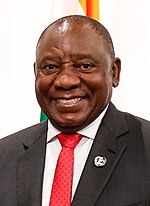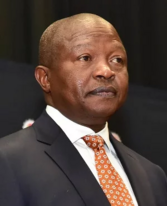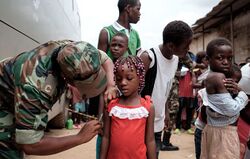Tabora
This article is incomplete because it is pending further input from participants, or it is a work-in-progress by one author. Please comment on this article's talk page to share your input, comments and questions. Note: To contribute to this article, you may need to seek help from the author(s) of this page. |
Free Republic of Tabora | |
|---|---|
| Motto: Masisukume sakhe ("Let us rise and build") | |
 Tabora in dark blue, Coius in light blue | |
| Capital | Ntendeka |
| Largest city | Mbiza |
| Official languages | Banu Sisulu Njinji Maswana |
| Ethnic groups | 98.3% Black Bahian (75% Banu, 18% Sisulu, 4% Njinji, 3% Maswana) 0.7% White Bahian 1.0% Others |
| Demonym(s) | Taborian |
| Government | Unitary presidential republic |
| Dumisani Kumalo | |
| Mafika Gwala | |
| Tembeka Rubusana | |
| Legislature | Assembly of the Republic |
| Independence from Werania | |
• Declared | 1942 |
| 1942-1950 | |
| 18 April 1950 | |
• People's Republic proclaimed | 22 September 1971 |
| 2002 | |
• Current constitution | 2014 |
| Population | |
• 2019 estimate | |
• 2015 census | 25,368,240 |
| GDP (PPP) | 2019 estimate |
• Total | |
• Per capita | |
| GDP (nominal) | 2019 estimate |
• Total | |
• Per capita | |
| Gini | 31.8 medium |
| HDI | 0.538 low |
| Currency | Taborian denier (TBD) |
| Date format | dd-mm-yyyy |
| Driving side | left |
| Calling code | +52 |
| Internet TLD | .tb |
Tabora, officially the Free Republic of Tabora, is a country in the eastern portion of the Bahia subcontinent of the Coius continent. It is bordered by Habasha and Garambura to the west, the Coast of Bahia to the north and east and the Banfura Sea to the south. It's capital is Ndenteka, while its largest metropolis is Mbiza. With a population of 28.7 million it is one of the largest in Bahia, however it remains one of the poorest in the world with a GDP per capita of $2,905.
Since the latter half of the 11th century, much of Tabora had fallen under the influence of the veRwizi Empire, while smaller territories in the north of the country remained independent. This would remain stable until the arrival of the Weranians in XXXX, who steadily increased their presence through the construction of trading outposts at XX (modern day Mbiza) and XX (modern day Empembeni). Weranic dominance would culminate in the creation of XX in XXXX. Tabora would become a major source of gold and silver for Werania throughout much of the 19th century, while its vast fertile plains drew the settling of Weranic farmers. The Great War saw Tabora fall under Gaullican occupation throughout much of the war, where the functionalist regime extended its anti-Bahian culture oppression from neighboring Garambura. Following the end of the Great War and the return of Werania, Taborian nationalists led by the Imbube Yenkululeko declared independence, sparking the nine-year Taborian War. Using guerilla warfare and terror tactics against the Weranians, Tabora ultimately secured independence in 1950.
In wake of independence, the various militias and rebel groups began fighting among themselves for post-war control over the country. In 1952, Thamsanqa Nzimande captured Ntendeka and stabilised the country. However, by 1956 intermittent clashes with rebel holdouts destabilised Tabora and Nzimande was overthrown by Butana Mdutyana who would rule Tabora until 1971 through violence and authoritarianism. In 1971, rebels under the Taborian Revolutionary Front overthrew Mdutyana's government and established the People's Republic of Tabora. Throughout the 1980s and 1990s, the country suffered from a series of low-level insurgencies, while the socialist government further undermined tribal identities, though some economic success was recorded with a modernisation of mines and agriculture. However, corruption, authoritarianism and growing health crises led to the overthrow of the socialist regime in the Taborian Revolution in 2002. The revolution gave way to a democratic presidential republic and a multi-party system. Since 2002, Tabora has experienced its longest period of peace and stability, with free and fair elections at all levels recorded. Since 2002, the Taborian economy has grown on average by 4-5% per year and numerous public health campaigns have aided development. In 2012, the first peaceful transition of power took place when Jonas Nofomela took over from Thulas Nxesi, the second peaceful transition occurred in 2014 when the National Jubilee Party defeated the long-ruling Party 2002 in that year's general election.
Today, Tabora ranks as one of the fastest growing developing economies in the world. In the modern day, Tabora is a founding member of the Congress of Bahian States, and a member of the ICD, CoN, the ITO and GIFA.
History
Pre-history
Pre-colonial
Early colonial
Silberküste
Late colonial
Independence and civil war
People's Republic
Modern
Geography
Tabora is located in eastern Bahia, bordering Habasha and Garambura to the west and is bounded by the Coast of Bahia to the east, north and south. It has a total land area of 393,505 km² (151,933.13 mile square), making it the Xth largest country in Bahia and the xth largest in Bahia-Coius. Much of Tabora's geography is dominated by two separate geo-regions, the first being the Coastal Strip (Imichilo Yasogwini) and the Heartland (Inhliziyo). The two are separated by the Iphayona Mountains also known as the Great Escarpment, which run north-to-south, parallel to the eastern coastline.
West of the Iphayona mountains, much of Tabora is dominated by the Inhliziyo. Its flat terrain and climate has seen the region become host to some of Tabora's vital commerical farming regions and many of its largest urban areas. Agriculture across the region is generally dominated by extensive grain production and the grazing of beef cattle, with more intensive production of maize, wheat, sorghum, citrus fruits, groundnuts, sunflowers, and vegetables, occurring in irrigated areas and farmland closer to urban areas. The peat base of the grassland acts as a natural filter, providing sources of clean water.
The coastal strip, east of the Iphayona, moving clockwise from the north, consists of the iBhande Lasenyakatho, which merges into the iBhande Lasempumalanga. This is hotter, drier and less intensely cultivated than the Inhliziyo. Running south to west of the Iphayona the annual rainfall increases as one enters the southern and western coastal regions, these regions are subtropically hot and humid.
Government and politics
Tabora is a unitary constitutional presidential republic and a multi-party democracy. The current Constitution of Tabora was approved by referendum on 28 September 2012. It greatly strengthened the authority of the executive in relation to parliament. The executive branch itself is concentrated around the President of the Republic; currently Dumisani Kumalo, who is elected by direct-popular election every five years for a maximum of two terms. The President is subordinated by the Deputy President of the Republic; currently Mafika Gwala, and by a Prime Minister; currently Tembeka Rubusana. The Deputy President and Prime Minister are appointed by the President. The Prime Minister is the head of government, though is constitutionally limited in power.
The Assembly of the Republic is the unicameral legislature. The Assembly of the Republic is elected every five years by universal suffrage. The assembly represents local constituencies and has the power to remove the sitting government and president. The Assembly of the Republic has 190 seats, with elections using the D'hondt method. Since the 2002 Revolution, Taborian politics have been dominated by the National Jubilee Party, the Party 2002 and the Party of the Revolution.
Law
Foreign relations
Human rights
Administrative divisions
From independence until 2002, all local governments operated by the Weranic colonial authorities were abolished and governed directly by the central government. While this enabled the leftist regime (1971-2002) the ability to direct resources more effectiently, it denied many regions of Tabora the policy flexibility to meet rising challenges or difficulties. In wake of the 2002 Revolution, local and rural authorities were established. In 2013, the new constitution reorganised Tabora into 18 regions (Isifunda), which in turn were comprised of districts (Isigodi). As of 2013, Tabora is comprised of 18 regions and 180 districts. 27 districts are classified as urban, while the remainder are classified as either rural or rural-urban.
The urban districts have an autonomous city, municipal, or town council and are subdivided into wards. The non-urban units have an autonomous district council but are subdivided into village councils or township authorities (first level) and then into umphakathi (second level).
Military
The military of Tabora is coordinated under the Taborian Armed Forces, which consists of the Taborian Army, Taborian Navy and the Taborian Air Force. As of 2018, the armed forces had a total strength of 105,000 personnel.

Since the Taborian Revolution, the armed forces have been steadily modernised with the assistance of several Euclean states, through the Euclean Community Mission in Tabora (ECMT). The armed forces since 2002 have also been engaged in confronting the low-level insurgencies and ethnic clashes centred in the south-west and north-west. Since 2019, 2,500 Taborian soldiers have been provided for Bahian peacekeeping missions, with plans to provided 1,200 soldiers for international peacekeeping by 2028.
Per the 2003 constitution, the President of Tabora is the commander-in-chief and the military command is subject to the oversight and authority of the Minister of Defence. 2013 amendments enforced changes that permit military deployments only as a result of parliamentary votes.
Economy
Demographics
| Historical population | ||
|---|---|---|
| Year | Pop. | ±% |
| 1935 | 4,155,412 | — |
| 1945 | 6,251,671 | +50.4% |
| 1955 | 10,001,214 | +60.0% |
| 1965 | 13,225,712 | +32.2% |
| 1975 | 18,559,803 | +40.3% |
| 1985 | 19,666,500 | +6.0% |
| 1995 | 21,497,531 | +9.3% |
| 2005 | 23,669,874 | +10.1% |
| 2015 | 25,368,240 | +7.2% |
| Source: Weranian Colonial Register (1935-1945) Taborian National Census (1955-2015) | ||
Ethnic groups
Tabora has a population of 25,368,240 inhabitants according to the results of its 2015 census, the third consecutive carried out since 1995. It is composed of Banu 75%, Sisulu 18%, Njinji 4%, Maswana 3%, 0.7% white or mixed Bahian-Euclean and other ethnic groups 1%. The Banu form a majority of the population, at 75%. The population is forecast to grow to over 40 million people by 2050, aided by a steady improvement in infant-mortality rates and successfully public health programs. As of 2019, it is estimated that Tabora has a population of 28.7 million.
Languages
The languages in Tabora are those originally spoken by the different ethnic groups and Weranian, introduced during the Weranian colonial period. The most widely spoken indigenous languages are isiBanu, Sisulu and Njinji, in that order; these three languages alongside Maswana are the official languages of Tabora.
Following independence from Werania in 1950, the Weranic language was stripped of any official recognition and was actively suppressed by the new government. Efforts to replace Weranic as the primary languge with isiBanu proved deeply divisive. In wake of the Taborian Revolutionary Front's siezure of power in 1971, the collectivist regime instead sought to promote national harmony by elevating the three most widely spoken indigenous languages, while placing a focus on the widespread teaching of isiBanu to aid development. The promotion of all three languages, while focusing on Banu for official businesses and government has been continued under the democratic government. Since 2014, all Taborian schoolchildren are taught the three official languages, as such, Tabora has one of the highest concentrations of multi-lingual speakers in the world.
According to the 2015 census, for first languages isiBanu is spoken by 77% of Taborians, Sisulu by 16%, Njinji by 4%, Maswana by 3% and other languages by 1.7%. For second and third languages, isiBanu is spoken by 89% of Taborians, Sisulu by 80% of Taborians and Njinji by 77%.
Religion
As of the 2015 census, 96.5% of the population, or 23,972,986 are Sotirians. An overwhelming majority of 90.1% of Sotirians, or 21,599,660 Taborians, are Solarian Catholic. 6.6% or 1,582,217 Taborians are Amendist, while 2.3% or 551,378 Taborians belong to Kasperist churches.
The remaining 3.5% or 887,888 Taborians are listed as "Abantu" or "Folk religions". Traditional religions embody such concepts as monotheism, animism, vitalism, spirit and ancestor worship, witchcraft, and sorcery and vary widely among ethnic groups. The syncretic sects often merge elements of Sotiranity with traditional beliefs and rituals and are not recognized by mainstream churches as part of Sotiranity. Since 2002, tensions between the Catholic majority and those of Traditional faiths have been a long-running issue for government. Sectarian violence has been known, yet sporadic, especially in the north-west and south-west of the country.
Health
Healthcare has been a primary focus and concern of successive governments since the 2002 Revolution. From 1960 to 2004, Tabora had one of the highest infant mortality rates in the world and one of the world's lowest life expectancies, however, succcessful healthcare reforms and major government-led public health programs has seen significant improvements in public health. As of 2016, the infant mortality ratio had fallen from 204 deaths per 1,000 live births to 35.2 per 1,000 live births.
Epidemics of cholera, malaria and hemorrhagic fevers, are common diseases in several parts of the country. Many regions in this country have high incidence rates of tuberculosis and high HIV prevalence rates. Dengue, filariasis, leishmaniasis and onchocerciasis (river blindness) are other diseases carried by insects that also occur in several regions. Epidemics have become the government's principal concern in wake of its success in reducing infant mortality rates. Areas of poor transportation, access and development have been earmarked for major healthcare investments.
In 2016, the Ministry of Health was expanded to include the National Department for Vaccination and Disease Control (NDVDC). The body is widely accepted as one of the most powerful public health bodies in the world, with the power of prosecution and mandatory vaccination. The NDVDC is assisted by the military in implementing mass vaccinations.
In 2017, the NDVDC launched a national campaign of vaccination against measles and polio, extended to every child under ten years old and aiming to go to all 18 regions in the country. The campaign includes a proper dealing with measles and polio cases, strengthening routine immunisation, national media campaigns, introducing a second dose of vaccination in the National Mandatory Vaccination Routine and active epidemiological surveillance for measles and polio.
Education
Children attend nursery school, or kindergarten in the private sector until they are five years old. This lasts one to three years (KG1, KG2 and KG3) and is financed privately, efforts by the Taborian government to establish a formal state-system for the KG stages have been launched as of 2017.
Basic formal education starts at age six years and lasts 12 years consisting of eight years in primary school and four years in high school or secondary school. Primary school is free in public schools and those attending can join a vocational youth/village polytechnic or make their own arrangements for an apprenticeship program and learn a trade such as tailoring, carpentry, motor vehicle repair, brick-laying and masonry for about two years.
Those who complete high school can join a polytechnic or other technical college and study for three years, or proceed directly to the university and study for four years. Graduates from the polytechnics and colleges can then join the workforce and later obtain a specialised higher diploma qualification after a further one to two years of training, or join the university—usually in the second or third year of their respective course. The higher diploma is accepted by many employers in place of a bachelor's degree and direct or accelerated admission to post-graduate studies is possible in some universities.
In 2017, the literacy rate in Tabora for persons aged 15 and over was estimated to be 73.8 percent. Education is compulsory until children reach age 15. In 2010, 78.1 percent of children age 5 to 14 years were attending school. The primary school completion rate was 80.8 percent in 2017. In recent years, the Taborian government has worked to expand primary schools across rural regions where completion and literacy rates are at their lowest. The government has sought to use state-services as well as cooperation with the Catholic Church to provide schooling for the poorest families.











